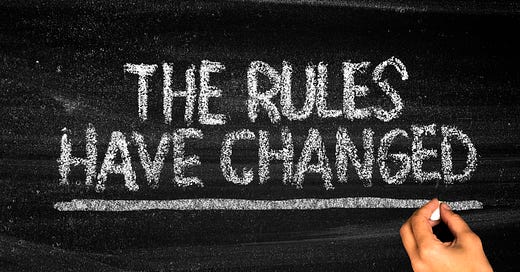The Nine Easy Steps (and One Lie) to Avoid Disruption
The Digital Leader Newsletter — Strategies and Techniques for Change Agents, Strategists and Innovators.
The species that survives is the one that is able best to adapt and adjust to the changing environment in which it finds itself — Charles Darwin
Adapting, another word for “innovating”. The history of category-leading companies successfully “adapting” from one era to the next era is short. What examples of category-leading companies which transition era can you think of? This is the essential challenge of business model evolution and “eating your young”.
Microsoft is a strong example of a company that is currently transitioning from the dominant force in the software license PC “Wintel” era to the recurring revenue, highly available, software and operating infrastructure cloud computing era. From the dominant company of one era to a still dominant company in another.
An easier list to develop is a list of companies that were once the high-growth, high-margin, new technology, new model businesses which are now being commoditized and facing threats. They have gone from being the cheetah to being the gazelle.
Whether it comes fast or slow, many established business models are facing disruptive technologies and business model innovation. How do you avoid disruption?
I gave a keynote this week to an audience of large insurance company executives on this topic — how do you avoid disruption?
Nine Easy Steps and One Lie to Avoid Disruption
Step 1: Explore Early
Going from “big to bigger” is what most companies and executives are trained in our corporate playbooks geared to. But, to go from “nothing to something”, to start a new business within a company, often requires guided wandering. Create themes and megatrends which you believe will create future markets and ways to serve customers. Within these investment themes, create your version of an educational journey to better understand the topic, the trend, and what the early explorers are learning.
Wandering in business is not efficient … but it’s also not random. It’s guided – by hunch, gut, intuition, curiosity, and powered by a deep conviction that the prize for customers is big enough that it’s worth being a little messy and tangential to find our way there — Amazon 2018 Shareholder Letter
Step 2: Be Customer-Centric
Customer-centricity not only means working hard to improve customer satisfaction for today’s customers, it means making it everybody’s job to understand the customer and what unmet needs could be met. Customer-centric organizations look at the customer experience in a broad view, wider than just their current intersection with the customer. They understand the broad “job to be done” and the entire context of the customer’s day. This curiosity about the customer and their needs will create insights for growth and experimentation.
Step 3: Be Agile
The agile organization is one that is good at a couple of things. First, they are good at shipping new products and new capabilities. Second, they are good at understanding how to define and test hypotheses in systematic, quick, and cheap cycles. This innate orientation to shipping products and to using data and customer feedback via testing is the core muscle group used to innovate new capabilities.
Step 4: Be Misunderstood
If your new business models, features, and customer orientation threaten the status quo and tradition, except that the first moves your threatened competition will do is tell the market that you don’t know what you are doing, that your concept won’t work, that it is unsustainable. Be ready to be “misunderstood”, often for a long period of time.
Step 5: Be a Perfectionist
This is not “the lie” in “nine truths and one lie”! Operational excellence (OE) is focused on making today’s operations and today’s customer experience and working toward making it “perfect”. This discipline of understanding controllable variation and working to eliminate it along with the connected quality issues, costs, latencies, safety issues, and mistakes creates incremental improvements. OE also points out where non-incremental innovation is needed, feeding into areas for you to “explore early” (step 1) and find disruptive technology and innovations
Step 6: Be Patient
I believe this is Amazon’s hidden superpower. Be patient for the market to develop, for customer adoption to develop, for your capability to mature. Knowing when to be patient on a new idea versus when to withdraw has to be done on a case-by-case basis.
Here’s a history lesson. What company first came out with a local search business? It was Microsoft and it was called “Sidewalk”. First launched in 1997, Microsoft sold the project to Citysearch in 1999. “Sidewalk is one we should not have gotten out of,” said Steve Balmer. Executive insiders have told me that compared with the big P&L’s of Windows and Office products, Microsoft couldn’t understand that patience was needed, a different playbook and perspective, as the market for internet search was nascent at the time.
[You can’t help but smile at this… Windows ‘95 launch “dance”]
Step 7: Be Fast
Speed in business matters. When a company is “experimenting” and conducting agile tests, make them small and make them fast. You are optimizing for “speed to learning”. What gets in the way? Normal company policies and processes. Everything from hiring, contracting, legal review, IT to budget approval.
Separate out the teams running experiments. Give them a clear mission, and clear decision-making rights. Work early with key internal stakeholders and help them understand that the missions of these teams are different.
Step 8: Be Risky
When we are experimenting, we are making “bets”. If we already have very high confidence in an idea, we should still do it, but it’s not a bet. Innovating requires trying concepts for which we don’t know what the outcome will be or exactly what combination of factors is needed. That is a bet.
But there is also a half-lie here. We are de-risking the longer-term viability of a company by pursuing the agenda of growth and innovation.
Step 9: Deliver Results
The emphasis of this step is two-fold. First, deliver the right results based on the timing of a business or product. Early on, the right results are focused on “adoption” and finding product-market fit. Then, the right results are focused on getting to target unit costs and finalizing distribution and marketing. When you are scaling, then bring out the traditional P&L forecasting.
The second emphasis is regardless of what phase, focus on both output metrics and results, and with equal vigor, perhaps more, outline and debate the controllable inputs we are planning and committing to which we believe lead to these outputs.
The Big Lie
I made the lie easy to call out. The lie is that these are *not* easy steps. The hardest part is the conviction to invest now and follow these steps, the results we are seeking will follow. This takes leadership and commitment from the top.
Guess who invented the graphical user interface, the mouse, laser printers, ethernet, and object-oriented programming? Xerox Parc — the fabled organization which stole defeat out of the jaws of victory. While they “invented”, they didn’t understand how to progress with these invented capabilities in relation to their GREAT business, the copier. And the rest is history. As Darwin said, “adapt or die”.
Your Homework
Which of these “steps” is your company strong at? Can you leverage these strengths and perhaps awareness of existing threats to create an executive conversation on taking the right steps to innovate?
About The Digital Leader Newsletter
This is a newsletter for change agents, strategists, and innovators. The Digital Leader Newsletter is a weekly coaching session with a focus on customer-centricity, innovation, and strategy. We deliver practical theory, examples, tools, and techniques to help you build better strategies, better plans, better solutions — but most of all to think and communicate better.
Please share and comment! Thanks





